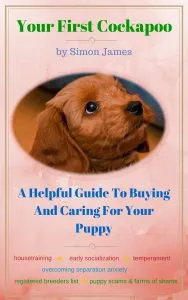Cockapoo Grooming and health
It’s important to have a grooming regime to keep any dog healthy, particularly those with thicker or longer fur.
Grooming is not just about trimming the fur, it’s also about ensuring the eyes are not obscured, the nails are not too long and the ears are looked after.
Grooming/brushing sessions are also an excellent opportunity to examine your dog’s skin for any growths, lumps, bumps or wounds and to have a good look at his ears, eyes and mouth.
Build into your dog’s grooming regime a pattern of small treats and praise so he or she feels content. This should be the case whether you or a paid groomer carries out the work
Ears
Attention will also have to be paid to inside the ear canal as, like Poodles, some Cockapoos grow excess hair inside the ear that will trap ear wax. “Pluck-it” or “Thornit” canker powder can be used to help grip these hairs which need to be plucked out of the ears either with yours or your groomer’s fingers.
Vigilant prevention is the hallmark of good healthcare for all companion animals. Watch for any discharge from the eyes or ears, as well as evidence of accumulated debris in the ear canal accompanied by a foul or yeasty odor. (This is a sign of parasitical mite activity.)
Thoroughly rinse your dog’s coat with clean fresh water to remove all residues. Towel your pet dry and make sure he doesn’t get cold.
Anal Glands
All dogs can suffer from blocked anal glands, typically indicated by the dog rubbing its bottom on the ground or carpet. (You may also notice an odour.) If this occurs, the glands will need to be expressed to prevent an abscess from forming. This is a sensitive task and one that a veterinarian or a highly experienced groomer should perform.
Fleas
I’m including fleas and ticks under grooming because both are typically discovered by and addressed through grooming sessions. Don’t think that if your Cockapoo suddenly has “passengers” you’re doing something wrong, or that the dog is at fault. This is simply part of dog ownership for you to deal with. Sooner or later, it will happen.
Of course the problem needs to be dealt with immediately, but it’s not a reason to freak out.
Do NOT use a commercial flea product on a puppy of less than 12 weeks of age and be extremely careful with adult dogs.
Most of the major products contain pyrethrum. This chemical has been responsible for adverse reactions, including long-term neurological damage and even fatalities in small dogs.
To get rid of fleas, bathe your dog in warm water with a standard canine shampoo. Comb the animal’s fur with a fine-toothed flea comb, which will trap the live parasites. Repeatedly submerge the comb in hot soapy water to kill the fleas.
Wash all of the dog’s bedding and any soft materials with which he has come in contact. Look for any accumulations of “flea dirt,” which is excreted blood from adult fleas. Wash the bedding and other surfaces daily for at least a week to kill any remaining eggs before they hatch.
If you find a tick, coat it with a thick layer of petroleum jelly for 5 minutes to suffocate the parasite which causes its jaws to release.
Pluck the tick off with a pair of tweezers using a straight motion. Never just jerk a tick off a dog. The parasite’s head will be left behind and will continue to burrow into the skin, making a painful sore.
TIP: If you bath your dog at home in between clippings, do not get your pet’s head and ears wet. Clean the dog’s head and face with a warm, wet washcloth only.


